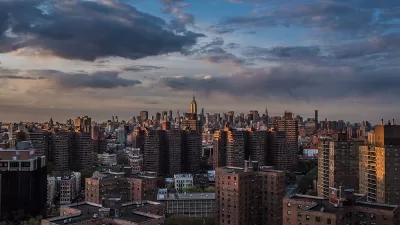New York City Mayor Bill de Blasio announced the details of the "Housing New York" plan this week. The plan will guide the de Blasio Administration toward its goal of creating 200,000 affordable housing units in the city.

"New York City will commit $8.2 billion in public funds to a 10-year housing plan that could transform the cityscape from Cypress Hills in Brooklyn to the shores of the Harlem River," according to an article by Mireya Navarro and Michael N. Grynbaum in the New York Times.
The $41.1 billion, ten-year plan will require "$2.9 billion in state and federal money and more than $30 billion the city expects to attract in private funds." That investment will earn the city 80,000 new affordable units while preserving 120,000 currently existing units.
Mayor de Blasio is quoted in the article describing the plan as, “a central pillar in the battle against inequality.”
Writing for The Architect's Newspaper, Henry Melcher adds details about the policy mechanisms included in the plan, as well their implications for the city's skyline. "As expected, one of the central pieces of de Blasio’s plan is 'mandatory inclusionary zoning,' which will require developers to include below market-rate units at rezoned sites."
Melcher shares more details from the report: "the City will also 're-examine parking requirements, zoning envelope constraints, and restrictions on the transferability of development rights.' It is also launching two programs to incentive development on vacant lots."
Melcher does the math and concludes, "De Blasio’s New York will likely be a denser New York," which, he adds, is likely to please the construction and architecture industries.
Stephen J. Miller, writing for Next City, also provides analysis of the plan, called the "Housing New York: A Five-Borough, Ten-Year Plan," which begins by comparing the new plan to Mayor de Blasio's campaign platform.
Miller finds that the growth of total housing in New York City under Mayor de Blasio's current housing proposals will equal the rate under Bloomberg—five percent over ten years.
Here, Miller details how Mayor de Blasio would spread funding among income groups: "Compared to the Bloomberg years, though, a much higher proportion of the new housing units created will be subsidized....De Blasio’s new-build affordable housing target is 60 percent higher than Bloomberg ended up with (and in two fewer years), even if it doesn’t quite measure up to what he promised on the campaign trail. And of those units, four times as many will be made available to the poorest class of working New Yorkers — which, for families of four, works out to those with incomes no greater than around $25,000 a year, with rents that don’t come near four digits."
FULL STORY: De Blasio Sets a 10-Year Plan for Housing, Putting the Focus on Affordability

Alabama: Trump Terminates Settlements for Black Communities Harmed By Raw Sewage
Trump deemed the landmark civil rights agreement “illegal DEI and environmental justice policy.”

Study: Maui’s Plan to Convert Vacation Rentals to Long-Term Housing Could Cause Nearly $1 Billion Economic Loss
The plan would reduce visitor accommodation by 25% resulting in 1,900 jobs lost.

Planetizen Federal Action Tracker
A weekly monitor of how Trump’s orders and actions are impacting planners and planning in America.

Grand Rapids Mayor Proposes Garage Conversion Plan
The mayor says allowing homeowners to convert garages to dwelling units could alleviate the city’s housing shortage.

Baltimore Ordered to Improve Sidewalk Accessibility
The city is one of many to face lawsuits for failing to comply with the Americans with Disabilities Act.

This Toronto Suburb Has More Bus Riders Than Columbus, Ohio
Brampton, Ontario used gradual improvements in service to prove that if you build it, they will ride.
Urban Design for Planners 1: Software Tools
This six-course series explores essential urban design concepts using open source software and equips planners with the tools they need to participate fully in the urban design process.
Planning for Universal Design
Learn the tools for implementing Universal Design in planning regulations.
Smith Gee Studio
Alamo Area Metropolitan Planning Organization
City of Santa Clarita
Institute for Housing and Urban Development Studies (IHS)
City of Grandview
Harvard GSD Executive Education
Toledo-Lucas County Plan Commissions
Salt Lake City
NYU Wagner Graduate School of Public Service




























